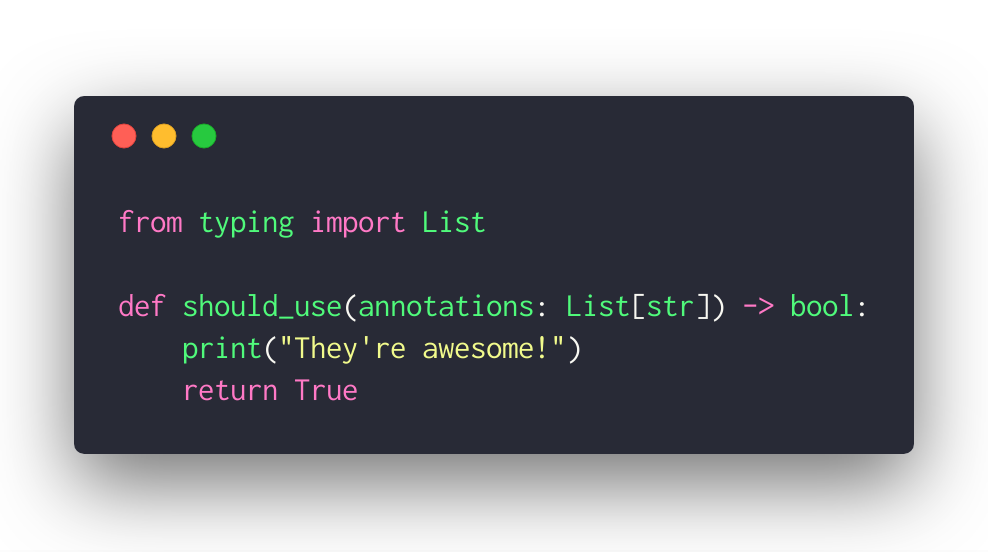Should I always use type hints in Python?
Should I always use type hints in Python?
The eternal question of whether to use type hints in Python!
As you embark on this journey, it's essential to understand that type hints are not mandatory in Python, but they can be incredibly beneficial for your code's maintainability, readability, and even performance. So, should you always use type hints? The answer is a resounding "maybe."
Here are some compelling reasons why you might want to use type hints:
Improved Code Readability: Type hints make it explicit what types of data your functions expect as input or return. This clarity can save other developers (or yourself, in the future) countless hours of debugging and guesswork. Better Static Analysis: Many popular Python IDEs and linters, such as PyCharm, VSCode, and Mypy, take advantage of type hints to provide better code analysis, warnings, and even errors. This enables you to catch potential issues before running the code, making your development process more efficient. Performance Optimization: In some cases, Python's built-in dynamic typing can lead to performance bottlenecks when dealing with complex data structures or large datasets. Type hints can help guide Python's type inference and optimization processes, resulting in faster execution times for specific use cases. Type Safety: By specifying the expected types, you're essentially saying, "Hey, I know what kind of data this code expects or returns." This reduces the likelihood of runtime errors caused by unexpected data types. With type hints, your code is more robust and less prone to surprises at runtime.However, there are scenarios where type hints might not be necessary:
Legacy Code: If you're working with existing codebases that don't use type hints or have a complex refactoring process ahead of them, it might be wiser to focus on other priorities rather than introducing type hints. Dynamic Typing: Python's dynamic typing nature allows for flexibility and adaptability. In some cases, you might not need explicit type declarations if your code is self-documenting enough or relies heavily on duck typing (i.e., the idea that an object can be treated as another type if it has the necessary attributes). Over-Engineering: If you're overly enthusiastic about type hints and apply them everywhere without careful consideration, you might end up over-engineering your codebase. This could lead to unnecessary complexity, making your code harder to maintain.In conclusion:
Use type hints when working on complex projects with multiple developers or for specific performance-critical areas where optimization matters. Don't worry about using type hints in simple scripts or small projects where the benefits are less pronounced. Be mindful of potential over-engineering and strike a balance between explicitness and readability.Remember, Python's dynamic typing is its greatest strength. Type hints should be seen as a tool to complement your coding style, rather than a strict requirement.
What are type hints in Python?

In Python, type hints are annotations that provide information about the expected data type of a variable, function parameter, or return value. They were introduced in Python 3.5 as part of the language's type system and are intended to help developers write more readable and maintainable code.
Type hints are not enforced by the interpreter at runtime; instead, they serve as a way for developers to explicitly state the expected data types of variables, parameters, and return values. This can be especially useful when working with large codebases or when collaborating with other developers on a project.
Here's an example of how you might use type hints in Python:
def greet(name: str) -> None:
print(f"Hello, {name}!")
greet("John") # Output: Hello, John!
In this example, the greet function takes a single parameter name, which is expected to be a string (hence the type hint str). The function also returns nothing (None), as indicated by the type hint for the return value.
Using type hints can have several benefits:
Improved code readability: By explicitly stating the expected data types of variables and parameters, you can make your code easier to understand and maintain. Better error messages: When working with type-checked languages like TypeScript or Java, type hints can help generate more informative error messages if there's a mismatch between the expected and actual data types. Improved developer collaboration: Type hints can serve as a common language for developers working on a project together, helping to ensure that everyone is on the same page regarding the expected data types of variables and parameters.Python 3.5 introduced several type hinting features, including:
Thestr, int, float, etc. types to specify scalar values The list, tuple, dict, etc. types to specify composite values The Any type to indicate that a value can be any type The Union and Optional types to specify sets of possible types or optional parameters
You can use these type hints to provide more information about the expected data types of variables, function parameters, and return values. This can help make your code easier to read and maintain, as well as improve collaboration with other developers.
In summary, type hints are a way for Python developers to explicitly state the expected data types of variables, function parameters, and return values. While they're not enforced by the interpreter at runtime, they can still have several benefits when it comes to improving code readability, error messaging, and developer collaboration.





























